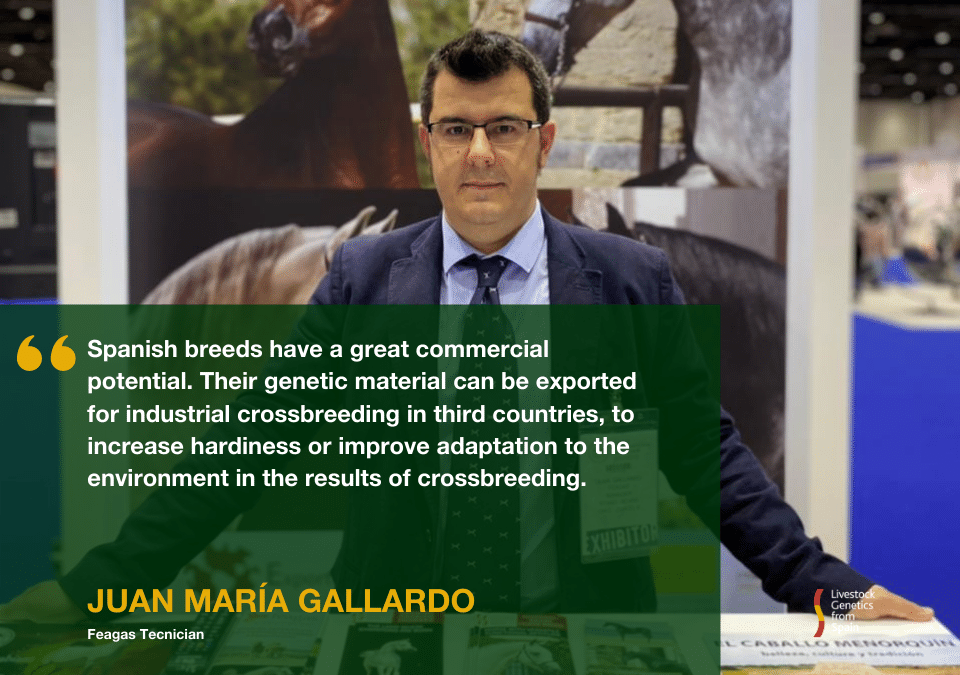- Marketing potential of each breed: requirements, conditioning factors…
Spanish breeds have a great commercial potential. It is true that the breeds in danger of extinction would not have enough specimens to export live animals, but their genetic material can be exported for industrial crossbreeding in third countries, to increase hardiness or improve adaptation to the environment in the results of crossbreeding.
By sector, the equine breeds that currently make up the LGFS have great potential:
- The Spanish Purebred is already in about 60 countries, so its success is already a fact.
- The Arabian Purebred is an international breed, although some animals born in Spain have been very successful in show and raid competitions. Moreover, in Spain we have our own line called Pure Spanish or Straight Spanish, which pure line and for has been very successful at an international level both in genetic crossbreeding.
- Regarding the Menorquin and the Spanish-Arabian Purebred, they have been very well received and have generated a lot of interest at the last fair in Dubai, so we feel that if we continue in this line of promotion, they will become better known.
In the sheep sector, LGFS currently has several breeds. Merina breed, which already conquered the world in its day and which the association is fighting to make it happen again, and there is also Assaf breed, which is very well known and is being exported quite a lot.
As for the Bovine Breeds, Rubia Gallega and Asturiana de los Valles breeds are quite international, with their genetic material being in several countries and successfully used for industrial crossbreeding. Avileña Negra Ibérica and Retinta breeds have a growing interest in South American countries for breeding and industrial crossbreeding.
As far as the goat sector is concerned, Florida, Murciano Granadina and Malagueña breeds are already exporting quite a few animals beyond our borders and, moreover, interest in these breeds is increasing due to their high productivity and hardiness.
In terms of conditions for shipments, each destination country has its own requirements and, moreover, these differ considerably depending on the species, which makes it difficult to summarise.
- Expansion of the catalogue: Are there plans to add more breeds?
Of course, the catalogue of breeds is dynamic and any breed wishing to do so may be added. We are still receiving membership documents to participate in this platform.
- Breeding and selection programmes as elements of breed improvement – What do they consist of?
As the Ministry states: Breeding programmes include the set of systematised actions, including the registration, selection, breeding and exchange of breeding animals and their reproductive material, designed and implemented to preserve and/or improve the desired phenotypic and/or genotypic characteristics in the target breeding population. Their purpose may be the preservation, improvement, reconstruction or creation of a breed, or a combination of these purposes. They must therefore contain the provisions affecting both the stud book and the activities aimed at achieving their purpose. Breeding programmes are developed by breeders’ associations officially recognised by the competent authorities. The breeding programme is a fundamental element for the organisation of the activities on a breed, in such a way that the breeder has the necessary information for the correct selection of the most suitable breeding stocks.
Further information on the breeding programmes for the different breeds can be found in the following link:
https://www.mapa.gob.es/es/ganaderia/temas/zootecnia/razas-ganaderas/programas-mejora/
- What does the improvement of the genetic line consist of? How is the highest profitability of the genetic line achieved?
The improvement of the genetic line consists of achieving an improvement of the animal genetics within the exploitation, being different the objectives of improvement within each farm and breeders.
Nowadays there are many tools and techniques that allow to improve these objectives, such as breeding stock catalogues, genomics, parentage, for example, which give the farmer very useful information to focus his selection or choice of breeding stock in order to make these exploitations more profitable and, in addition, an increasing development of assisted reproduction techniques: such as the use of cooled or frozen semen and embryo transfer, which allows the exchange of genetic material between exploitations without having to move the animals from their farms.
- Current situation of the livestock sector in Spain and evolution of exports since the creation of the GO ExportGen.
The truth is that the creation of GO Exportgen was born with very specific aims of international promotion, attendance at trade fairs, etc. But in recent years we have had to deal with the worst moment in terms of mobility and exports, as March 2020 meant the total closure of borders. Currently, exports are starting to move again, but there have been some months of great uncertainty, so these have also been affected. We hope that in the coming months these exports will increase and our presence in international fairs and events

